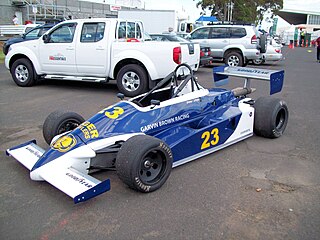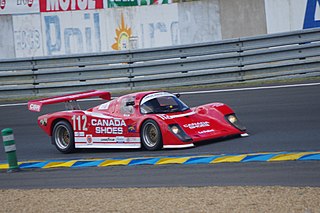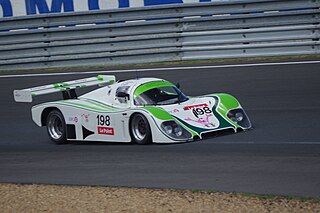Related Research Articles

Group C was a category of sports car racing introduced by the FIA in 1982 and continuing until 1993, with Group A for touring cars and Group B for GTs.

The 1985 24 Hours of Le Mans was the 53rd Grand Prix of Endurance, as well as the fourth round of the 1985 World Endurance Championship. It took place at the Circuit de la Sarthe, France, on 15 and 16 June 1985. The works Porsche team returned, with a Group C version of the 962. As favourites, they could expect from their customer teams and the works Lancias. In qualifying, Hans-Joachim Stuck set a new lap record in his works Porsche, with an average speed over 250 km/h for the first time. Mercedes returned for the first time in 30 years, as engine supplier to the Sauber team. The return was short-lived though, as the car got airborne in practice and crashed. With tighter fuel regulations this year from FISA, the teams would have to be more mindful of fuel economy and speed. However, from the start the Joest and Richard Lloyd Racing teams had the measure of the field. Working in tandem, Klaus Ludwig and Jonathon Palmer took turns leading and slipstreaming behind the other. Then at 9pm Jean-Claude Andruet had a major accident when his WM had a tyre blow out a high speed at the Mulsanne kink, sending him into the Armco barriers. Andruet was uninjured, but the race went behind the pace-cars for a half-hour as repairs were done. Just as the race resumed James Weaver pitted the RLR Porsche with an engine misfire. Traced to a faulty sensor, they returned to the race in 7th.

Spice Engineering was a British racing team founded by driver Gordon Spice with Raymond Bellm in the early 1980s, later becoming a successful sports car constructor in 1986. They competed in the World Sportscar Championship in Europe as well as the IMSA GT Championship in North America, at times partnering with major manufacturers such as General Motors and Honda as well as race engine manufacturer Comptech.

The 1984 Sandown 1000 was an endurance motor race staged at the Sandown Raceway in Victoria, Australia on 2 December 1984. It was the eleventh and final round of the 1984 FIA World Endurance Championship and was the first FIA World Championship race to be held in Australia. It was to be the first of a three-year contract to race at Sandown, though the final two years would be cancelled.

Tiga Race Cars Ltd. was a British auto racing constructor and team. The company was founded in 1974 by two former Formula 1 drivers, Australian Tim Schenken and New Zealander Howden Ganley. The company's name was formed by the first two letters of Tim and Ganley. Tiga constructed racing cars for various forms of open wheel racing and sports car racing, ranging from Formula Ford to the World Sportscar Championship.
Embassy Racing was a British auto racing team founded by Jonathan France in 2003. Initially created as a conjunction with Xero Competition in the British GT Championship, the team expanded to become an independent team and began to win races in British GT before the team took a sabbatical year in 2006. Upon their return to motorsport, Embassy moved to the international Le Mans Series, running in a Le Mans Prototype class, as well as entering the British Superbike Championship's junior leagues, the Supersport and Superstock Championships, running with the support of Triumph Motorcycles under the MAP Embassy Triumph banner.

The 1986 ADAC Kouros 1000 km Nürburgring was the seventh round of the 1986 World Sports-Prototype Championship. It took place at the Nürburgring, West Germany on August 24, 1986.
Sean Walker is a British former racing driver. He stopped racing in 2013. His father Ian Walker (1926–2008) was noted as the "Doyen of British Motorsport" was a driver, engineer and designer/modifier of race cars particularly Lotus. Ian Walker's cars were driven by famous drivers such as Jim Clark, Graham Hill and Peter Arundell.
The 1984 Australian Drivers' Championship was a CAMS sanctioned national motor racing title open to drivers of racing cars complying with Formula Mondial regulations.

John Bartlett is best known as a former WSCC race driver and team owner in the 1980's. He first started racing FF1600 cars in 1979 before moving into sports prototypes.
John Schneider is a former American sports car racing driver.
The Tiga GC84, also known as the Tiga GC284, is a sports prototype race car, designed, developed, and built by British manufacturer Tiga Race Cars, for sports car racing, conforming to the Group C1/C2 rules and regulations, in 1984.
The Dallara GC21 was a Le Mans Prototype built by Dallara for the Fuji Grand Champion Series, and based on one of the company's Formula Three cars. It was raced between 2002 and 2007, competing in the LMP2 class of the Japan Le Mans Challenge in the last two years of its usage. A GC21, entered by MYZ, won the LMP2 category of the Japan Le Mans Challenge in 2006.
The Lamborghini Countach QVX, occasionally referred to as the Lamborghini QVX, was a short-lived Group C sports racing car built in 1985. It was not built or designed by the Lamborghini factory, but instead used a Spice Engineering-built chassis and an engine derived from the Lamborghini Countach's V12. Lamborghini's British importer commissioned the car. Financial issues restricted it to one race, despite numerous entries in 1986 and a handful in 1987, but its one race showed the car had potential.

The March 85G was a mid-engined IMSA racing sports prototype, designed and developed by March Engineering in 1984 and used in sports car racing until 1988.

The Tiga GC287 is a sports prototype race car, designed, developed, and built by British manufacturer Tiga Race Cars, for sports car racing, conforming to the Group C2 rules and regulations, in 1987.

The Tiga GC286 is a sports prototype race car, designed, developed, and built by British manufacturer Tiga Race Cars, for sports car racing, conforming to the Group C2 rules and regulations, in 1986.
The 'Tiga GC83 is a sports prototype race car, designed, developed, and built by British manufacturer Tiga Race Cars, for sports car racing, conforming to the Group C1/C2 rules and regulations, in 1983.

The Tiga GC288 is a sports prototype race car, designed, developed, and built by British manufacturer Tiga Race Cars, for sports car racing, conforming to the Group C2/IMSA GTP Lights rules and regulations, in 1988.

The Tiga GC289 is a sports prototype race car, designed, developed, and built by British manufacturer Tiga Race Cars, for sports car racing, conforming to the Group C2/IMSA GTP Lights rules and regulations, in 1989.
References
- ↑ "1985 Tiga GC85 Cosworth Specifications". Ultimatecarpage.com.
- ↑ "Tiga GC285 - Photo Gallery - Racing Sports Cars".
- ↑ "World Sports Racing Prototypes - Tiga chassis numbers". www.wsrp.cz.